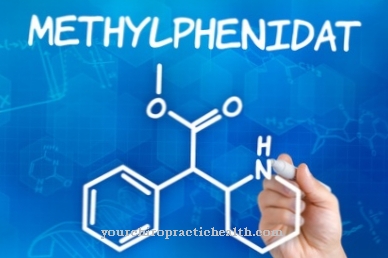The group of Diaminopyrimidines includes various active ingredients that are used medicinally as antibiotics. They all have a similar negative effect on the growth of bacteria in the human body. Due to their low reactivity with human organs, they are ideal as pharmaceuticals. The treatment leads to a rapid and complete healing of the symptoms without any significant side effects.
What are Diaminopyrimidines?
Diaminopyrimidines are organic compounds of two amines (diamino) with a heterocyclic pyrimidine ring. The ring consists of four carbon atoms into which two nitrogen atoms are integrated. Depending on the position of the two amino groups, four different structures (isomers) result, which are designated according to the position of the amines: 2,4-diaminopyrimidine, 2,5-diaminopyrimidine, 4,5-diaminopyrimidine and 4,6-diaminopyrimidine.
All four isomers are chemically identical, but have different reactivity towards other compounds due to the differently stored amines. The amino groups are very reactive (basic) towards acid compounds because of the hydrogen atoms.
Diaminopyrimidines are the basis for many pharmaceuticals.
Pharmacological effect
Diaminopyrimidines act as folic acid inhibitors. Folic acid (vitamin B9) is the cause of many harmful compounds. Folic acid is also converted into purines in the body, which can crystallize out. They can clog arteries and smaller organic ducts.
Folic acid is produced differently by the cells depending on the species. In bacteria it is reduced from dihydrofolate. This process produces tetrahydrofolic acid. Diaminopyrimidines and their chemical derivatives intervene in this process by inhibiting the enzyme dihydrofolate reductase. They prevent the corresponding compounds from coupling to the enzyme. This means that folic acid cannot be produced. Folic acid is depleted in the bacterial cell and ultimately it dies.
The antibacterial effect reaches a large number of pathogens, so that diaminopyrimidines play an important role in the derivation of antibiotics. They are similar in their effect to the sulfonamides. The isomers form starting materials for derivatives and thus also inhibit the antibiotic resistance of the bacteria.
Medical application & use
Various diaminopyrimidine-based agents are used in medicine. There are monotherapeutic agents such as trimethoprim, which only contain diaminopyrimidine. But there are also combination solutions with sulfonamides such as co-trimoxazole.
Doctors administer the two variants orally to combat bacterial urinary tract infections. The bacteria die after a short time (about 14-20 hours after ingestion) and are eliminated from the body.
Methotrexate is a derivative and is similar to folic acid. The bacterial cells build this into the cells instead of folic acid, which also leads to the depletion of folic acid and its death. It is mainly used by medical professionals in cancer therapy. Diaminopyrimidines have been shown to prevent cancer cells from spreading in clinical trials. Derivatives of these compounds are being tested, but are not approved.
In autoimmune diseases, it is used as a suppressor, which prevents the immune system from overreacting. Iclaprim, another derivative, can presumably be used for bacterial complaints from skin symptoms. It is currently in the approval process (as of 2016).
Further derivatives of diaminopyrimidines are used in rheumatism therapy, but also against hair loss. The structurally similar diaminopyridines are used in the treatment of neurological diseases.
In addition to its use as an antibiotic, its effectiveness against protozoa is also tested. In contrast to bacteria, protozoa are eukaryotic. They have a nucleus that bacteria do not have. Diaminopyrimidines can act directly in bacterial plasma, while in protozoa they have to penetrate the cell nucleus itself. This makes the effectiveness of the active ingredients more difficult. However, clinical studies show positive results.
Risks & side effects
The formation of folic acid is also important for the human body. The dihydrofolate reduction takes place in the cells. However, treatment with diaminopyrimidine cannot harm the human body due to its specific effect on bacteria. Medication with diaminopyrimidines is probably not significant enough to cause organic damage.
Bacterial folic acid producers are more susceptible than organic production. Since the effect of diaminopyrimidine is limited to bacteria and protozoa, it is highly tolerated. Occasionally, gastrointestinal complaints or nausea can occur.
The detection in the blood plasma decreases after a few hours. The body excretes diaminopyrimidines after about 12-14 hours. No further side effects have occurred to date.












.jpg)



.jpg)










.jpg)
